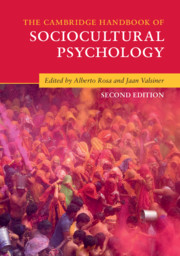Book contents
- The Cambridge Handbook of Sociocultural Psychology
- The Cambridge Handbook of Sociocultural Psychology
- Copyright page
- Contents
- Figures
- Tables
- Contributors
- Editors’ Introduction
- Part I Theoretical and Methodological Issues
- Part II Action, Objects, Artifacts, and Meaning
- Part III The Agent Rises a Reflective Self: Education and Development
- Part IV Institutional Artifacts for Value
- Part V Aesthetic and Religious Experiences
- Part VI Practices and Artifacts for Imagining Identity
- Part VII Experiences Make the Person
- General Conclusion
- Index
- References
Part IV - Institutional Artifacts for Value
Published online by Cambridge University Press: 25 June 2018
- The Cambridge Handbook of Sociocultural Psychology
- The Cambridge Handbook of Sociocultural Psychology
- Copyright page
- Contents
- Figures
- Tables
- Contributors
- Editors’ Introduction
- Part I Theoretical and Methodological Issues
- Part II Action, Objects, Artifacts, and Meaning
- Part III The Agent Rises a Reflective Self: Education and Development
- Part IV Institutional Artifacts for Value
- Part V Aesthetic and Religious Experiences
- Part VI Practices and Artifacts for Imagining Identity
- Part VII Experiences Make the Person
- General Conclusion
- Index
- References
- Type
- Chapter
- Information
- The Cambridge Handbook of Sociocultural Psychology , pp. 317 - 348Publisher: Cambridge University PressPrint publication year: 2018

